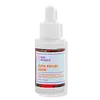What's inside
What's inside
 Key Ingredients
Key Ingredients

 Benefits
Benefits

 Concerns
Concerns

No concerns
 Ingredients Side-by-side
Ingredients Side-by-side

Snail Secretion Filtrate
Skin ConditioningGlycerin
HumectantCetyl Ethylhexanoate
EmollientDipropylene Glycol
HumectantDiisostearyl Malate
EmollientNiacinamide
SmoothingCetearyl Alcohol
EmollientChondrus Crispus Extract
Skin ConditioningSaccharum Officinarum Extract
MoisturisingHydrogenated Olive Oil
Skin Conditioning1,2-Hexanediol
Skin ConditioningButyrospermum Parkii Butter
Skin ConditioningPolysorbate 60
EmulsifyingBeeswax
Emulsion StabilisingAdenosine
Skin ConditioningAmmonium Acryloyldimethyltaurate/Vp Copolymer
Water
Skin ConditioningCaprylyl Glycol
EmollientCarbomer
Emulsion StabilisingCassia Angustifolia Seed Polysaccharide
Skin ConditioningCeramide NP
Skin ConditioningCitric Acid
BufferingDextrin
AbsorbentDimethicone
EmollientDisodium EDTA
Glyceryl Stearate
EmollientHydroxyethylcellulose
Emulsion StabilisingMadecassoside
AntioxidantOlea Europaea Fruit Oil
MaskingOlea Europaea Oil Unsaponifiables
Skin ConditioningPanthenol
Skin ConditioningParfum
MaskingPEG-100 Stearate
Sodium Hyaluronate
HumectantSodium Polyacrylate
AbsorbentSorbitan Sesquioleate
EmulsifyingStearic Acid
CleansingTheobroma Cacao Extract
Skin ConditioningTromethamine
BufferingPhenoxyethanol
PreservativeCitronellol
PerfumingLinalool
PerfumingCaramel
Cosmetic ColorantSnail Secretion Filtrate, Glycerin, Cetyl Ethylhexanoate, Dipropylene Glycol, Diisostearyl Malate, Niacinamide, Cetearyl Alcohol, Chondrus Crispus Extract, Saccharum Officinarum Extract, Hydrogenated Olive Oil, 1,2-Hexanediol, Butyrospermum Parkii Butter, Polysorbate 60, Beeswax, Adenosine, Ammonium Acryloyldimethyltaurate/Vp Copolymer, Water, Caprylyl Glycol, Carbomer, Cassia Angustifolia Seed Polysaccharide, Ceramide NP, Citric Acid, Dextrin, Dimethicone, Disodium EDTA, Glyceryl Stearate, Hydroxyethylcellulose, Madecassoside, Olea Europaea Fruit Oil, Olea Europaea Oil Unsaponifiables, Panthenol, Parfum, PEG-100 Stearate, Sodium Hyaluronate, Sodium Polyacrylate, Sorbitan Sesquioleate, Stearic Acid, Theobroma Cacao Extract, Tromethamine, Phenoxyethanol, Citronellol, Linalool, Caramel
Water
Skin ConditioningPropanediol
SolventGlycerin
HumectantAmmonium Acryloyldimethyltaurate/Vp Copolymer
1,2-Hexanediol
Skin ConditioningDiheptyl Succinate
EmollientCapryloyl Glycerin/Sebacic Acid Copolymer
Skin ConditioningGlycine
BufferingXanthan Gum
EmulsifyingEthylhexylglycerin
Skin ConditioningCaprylyl Glycol
EmollientAcetyl Hexapeptide-8
HumectantAcetyl Octapeptide-3
HumectantSodium Hyaluronate
HumectantCopper Tripeptide-1
Skin ConditioningTocopherol
AntioxidantWater, Propanediol, Glycerin, Ammonium Acryloyldimethyltaurate/Vp Copolymer, 1,2-Hexanediol, Diheptyl Succinate, Capryloyl Glycerin/Sebacic Acid Copolymer, Glycine, Xanthan Gum, Ethylhexylglycerin, Caprylyl Glycol, Acetyl Hexapeptide-8, Acetyl Octapeptide-3, Sodium Hyaluronate, Copper Tripeptide-1, Tocopherol
 Reviews
Reviews

Ingredients Explained
These ingredients are found in both products.
Ingredients higher up in an ingredient list are typically present in a larger amount.
1,2-Hexanediol is a synthetic liquid and another multi-functional powerhouse.
It is a:
- Humectant, drawing moisture into the skin
- Emollient, helping to soften skin
- Solvent, dispersing and stabilizing formulas
- Preservative booster, enhancing the antimicrobial activity of other preservatives
Ammonium Acryloyldimethyltaurate/Vp Copolymer (let's call it AAVC for short) is a synthetically created polymer. It's used as a film-forming agent and used to thicken the consistency of products.
AAVC is able to increase the consistency and viscosity of products due to its large molecule size. It also prevents ingredients from separating.
Caprylyl Glycol is a humectant and emollient, meaning it attracts and preserves moisture.
It is a common ingredient in many products, especially those designed to hydrate skin. The primary benefits are retaining moisture, skin softening, and promoting a healthy skin barrier.
Though Caprylyl Glycol is an alcohol derived from fatty acids, it is not the kind that can dry out skin.
This ingredient is also used as a preservative to extend the life of products. It has slight antimicrobial properties.
Learn more about Caprylyl GlycolGlycerin is already naturally found in your skin. It helps moisturize and protect your skin.
A study from 2016 found glycerin to be more effective as a humectant than AHAs and hyaluronic acid.
As a humectant, it helps the skin stay hydrated by pulling moisture to your skin. The low molecular weight of glycerin allows it to pull moisture into the deeper layers of your skin.
Hydrated skin improves your skin barrier; Your skin barrier helps protect against irritants and bacteria.
Glycerin has also been found to have antimicrobial and antiviral properties. Due to these properties, glycerin is often used in wound and burn treatments.
In cosmetics, glycerin is usually derived from plants such as soybean or palm. However, it can also be sourced from animals, such as tallow or animal fat.
This ingredient is organic, colorless, odorless, and non-toxic.
Glycerin is the name for this ingredient in American English. British English uses Glycerol/Glycerine.
Learn more about GlycerinSodium Hyaluronate is hyaluronic acid's salt form. It is commonly derived from the sodium salt of hyaluronic acid.
Like hyaluronic acid, it is great at holding water and acts as a humectant. This makes it a great skin hydrating ingredient.
Sodium Hyaluronate is naturally occurring in our bodies and is mostly found in eye fluid and joints.
These are some other common types of Hyaluronic Acid:
Learn more about Sodium HyaluronateWater. It's the most common cosmetic ingredient of all. You'll usually see it at the top of ingredient lists, meaning that it makes up the largest part of the product.
So why is it so popular? Water most often acts as a solvent - this means that it helps dissolve other ingredients into the formulation.
You'll also recognize water as that liquid we all need to stay alive. If you see this, drink a glass of water. Stay hydrated!
Learn more about Water